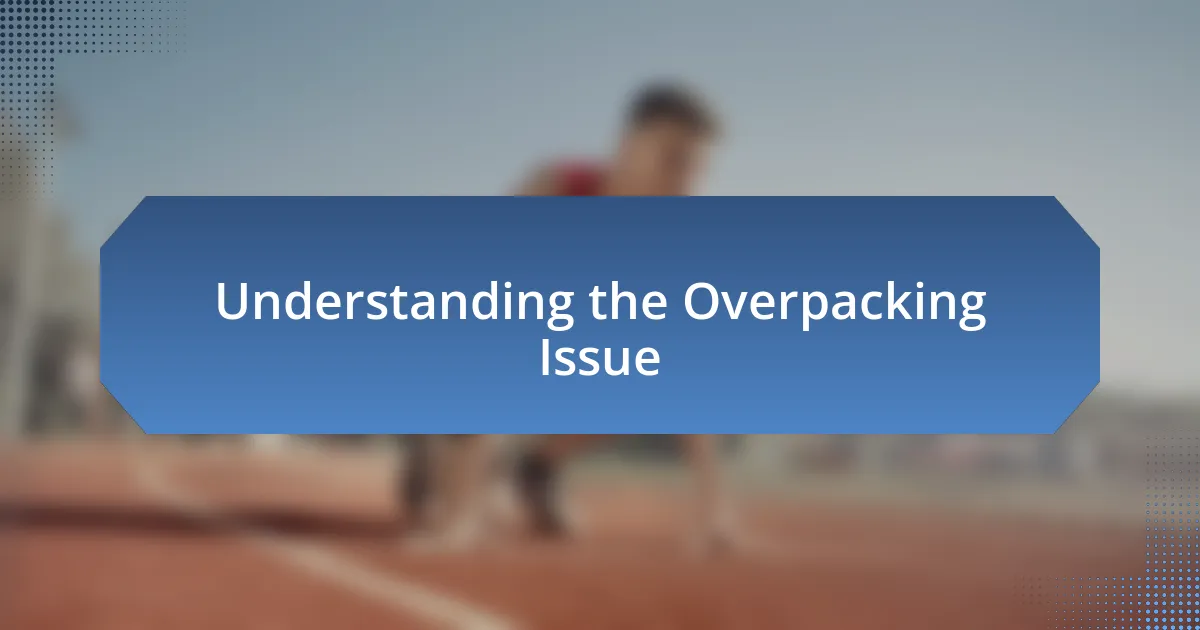Key takeaways:
- Overpacking often results from emotional factors, leading to heavier luggage and stress—embracing minimalism can enhance the travel experience.
- Creating a packing list and categorizing items ensures you pack only what you need, avoiding last-minute panics and forgotten essentials.
- Selecting the right luggage and using layering techniques maximizes space and offers versatility in outfits, making travel more manageable.
- Reflecting on packing choices after trips guides future decisions, helping to prioritize functional items over unnecessary ones.

Understanding the Overpacking Issue
Overpacking often stems from a fear of being unprepared. I remember a time when I packed an extra pair of shoes for a weekend getaway, convinced I might need them. When I arrived, I realized my obsession with ‘just in case’ items made my suitcase heavier and my travels more cumbersome.
Many of us tend to overestimate our clothing needs, thinking we’ll wear that third pair of pants or fifth shirt—only to find those choices remain untouched. Have you ever had a moment when, despite your best efforts, you ended up wearing the same outfit twice? It’s a common experience, and it highlights the emotional burden that overpacking can create, turning anticipation into stress.
Understanding the overpacking issue means recognizing how our emotions can lead to poor packing choices. It evokes a sense of security to have numerous options, but in reality, it weighs us down physically and emotionally. Reflecting on my travels, I’ve realized that embracing minimalism not only lightens my bags but also my mind, allowing me to focus on experiences rather than belongings.

Identifying Your Travel Needs
Identifying your travel needs is crucial to avoiding the trap of overpacking. I’ve learned to take a good look at my itinerary and the activities I’ve planned. For instance, during my last trip to the mountains, I carefully considered my hiking plans versus my desire to dress up for dinner and ended up packing appropriately for those specific events instead of whims.
Here’s a quick checklist to help clarify your travel needs:
- Determine the length of your trip.
- List the activities you plan to do each day.
- Check the weather forecast for your destination.
- Consider your accommodation—will there be laundry facilities?
- Think about your personal style preferences and what you feel comfortable wearing.
By thoughtfully assessing these factors, you can pack just what you need, ensuring that your luggage is manageable and that you have everything necessary for your adventure.

Choosing the Right Luggage
Choosing the right luggage can make a world of difference in your travels. I recall a trip where I opted for a lightweight carry-on instead of my usual large suitcase. It felt liberating to navigate the airport with ease, and I was thankful for the extra space to focus on my whirlwind itinerary instead of wrestling with my baggage.
When selecting luggage, size really matters. I often choose a suitcase that fits within airline carry-on regulations, which not only saves on baggage fees but also makes my travel experience smoother. For me, having a bag that’s spacious yet streamlined allows room for those little extras I might buy along the way—such as local snacks or unique souvenirs.
Durability and functionality are equally important. In my experience, a suitcase with wheels and multiple compartments helps keep everything organized, saving me from sifting through a chaotic jumble of clothes. It’s also worth considering travel gear that’s waterproof or resistant, especially if you’re adventuring in unpredictable climates—trust me, a rain-soaked backpack is a memory I prefer to avoid.
| Type of Luggage | Pros |
|---|---|
| Hard-shell Suitcase | Durable and protective; great for fragile items |
| Soft-shell Bag | Flexible, lightweight, often easier to store |
| Backpack | Hands-free convenience; ideal for active travel |
| Weekend Bag | Compact for short trips or quick getaways |

Creating a Packing List
Creating a packing list can be a game-changer for any traveler. I remember a time when I just relied on my memory and ended up forgetting essential items, like a charger for my phone. Now, I write everything down. It not only ensures I have what I need but also gives me peace of mind.
To make my packing list effective, I categorize items based on the nature of my trip. For instance, I separate clothing, toiletries, and travel documents. This method helps me visualize everything I need and prevents me from cramming random items into my suitcase at the last minute. Have you ever experienced that last-minute panic? I certainly have, and it’s not worth the stress.
I always refer back to my previous trips to refine my packing list over time. There are always lessons learned, like how I once packed five pairs of shoes for a weekend getaway—who needs that? By evaluating what I actually used, I’ve been able to streamline my future packing lists, making each trip less chaotic and more enjoyable.

Using Layering Techniques
Layering techniques are a smart way to maximize space in your luggage while keeping your outfits versatile. When I travel, I like to focus on lightweight fabrics that can be layered easily. For example, I’ll pair a tank top with a lightweight sweater and a versatile scarf. This way, I can adapt to different weather conditions without bundling up too much.
One of my favorite tricks is to use my bulky items, like a jacket or boots, as the foundation of my packing. I remember a trip where I wore my heaviest jacket on the plane, which not only kept me warm but also saved precious suitcase space. Have you thought about wearing your bulkier clothing during travel? It’s such a simple yet effective approach that can give you that extra room for souvenirs or other essentials.
As for the choice of colors, I stick to a cohesive palette to ensure that everything mixes and matches. This strategy not only simplifies packing but also enhances my overall travel experience. I recall packing a few neutral pieces and realizing how easy it was to change looks with just a swap of accessories. Isn’t it satisfying to travel light and still feel stylish?

Packing Smart Accessories
Smart accessories play a crucial role in my packing routine. I often include multi-functional items, like a sarong that can serve as a beach towel, a light blanket, or even a makeshift picnic spread. During one memorable trip, I used the same sarong as a scarf for a night out, demonstrating how a versatile accessory can shrink my suitcase significantly.
I also find that packing small tech gadgets, like a portable phone charger and a compact travel adapter, saves me from carrying multiple chargers for different devices. I once traveled without these essentials, and it was a nightmare trying to find compatible chargers abroad! Now, I always ensure these are among the first items I pack, knowing they’ll keep my devices charged and ready for use without adding bulk.
Another tip I can’t emphasize enough is to select jewelry that complements multiple outfits. A simple pair of earrings or a statement necklace can transform my look from day to night. I vividly recall one evening when I swapped out my daytime studs for a bolder option before heading out to dinner—it made me feel a bit more glamorous without my needing a whole new outfit. What accessories do you find elevate your travel style?

Evaluating Your Packing Success
Evaluating your packing success really comes down to reflection and adjustments. After each trip, I take a moment to assess what I used and what remained untouched. There have been times when I’ve brought an outfit I thought was essential but barely touched it. This realization pushed me to be more selective next time.
A practical method I use involves a packing checklist tailored to each destination. I remember a trip to a tropical location where I overpacked clothes but neglected sunblock and a reusable water bottle. That oversight taught me the importance of prioritizing functionality over quantity. Now, when I unpack, I also make a note of what accessories truly enhanced my experience.
Ultimately, I consider how I felt about my choices during the trip. Did I feel comfortable? Did I have what I needed for unexpected moments? These questions guide me to refine my packing strategy. Now, I often wonder how many others struggle with similar packing dilemmas. How do you assess your success and make packing decisions based on your experiences?


